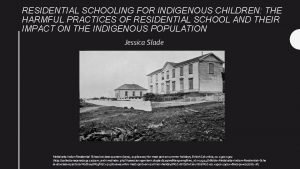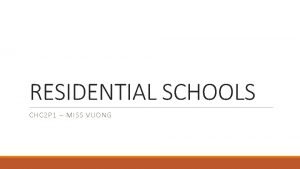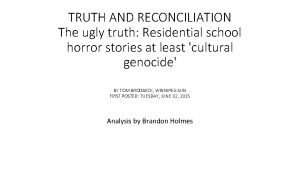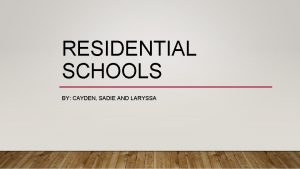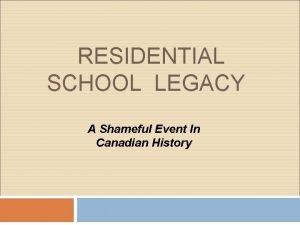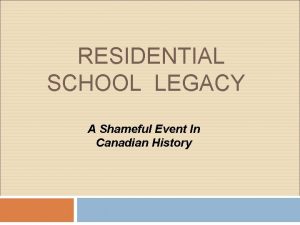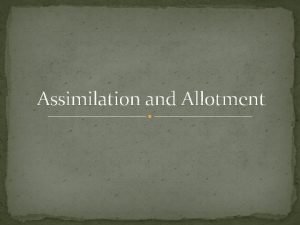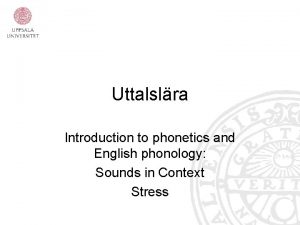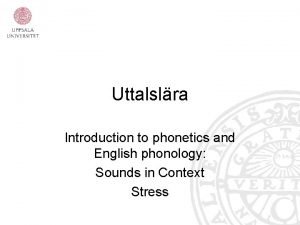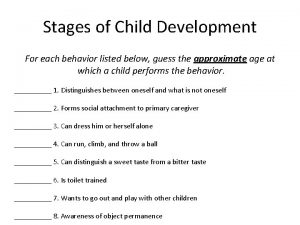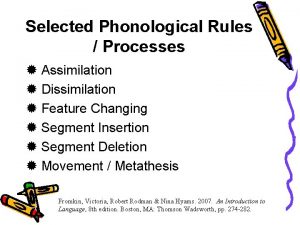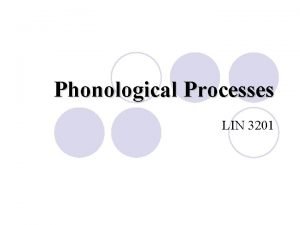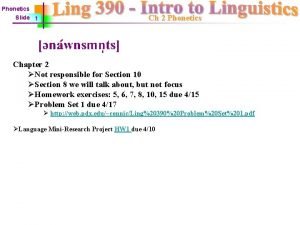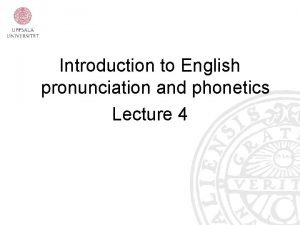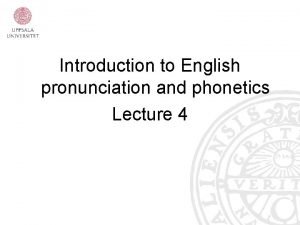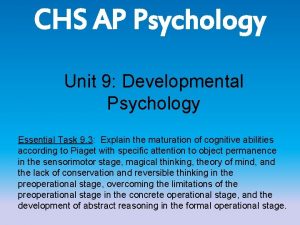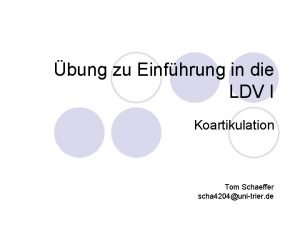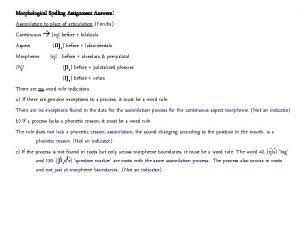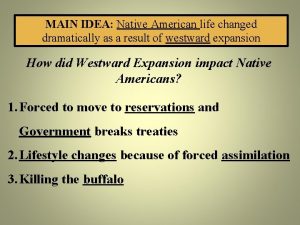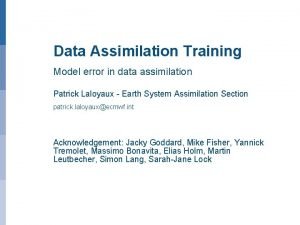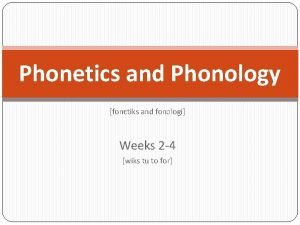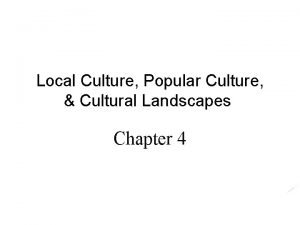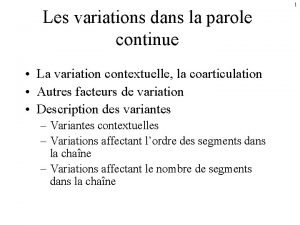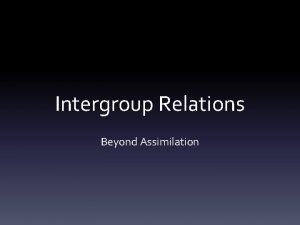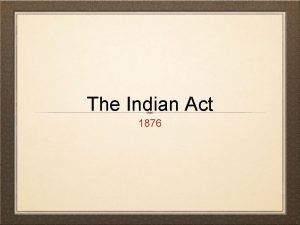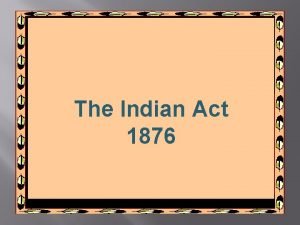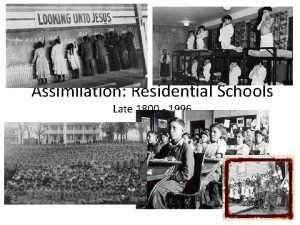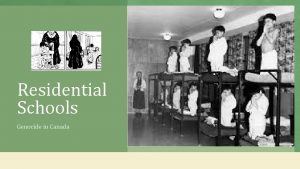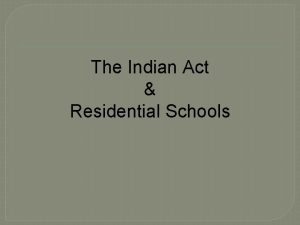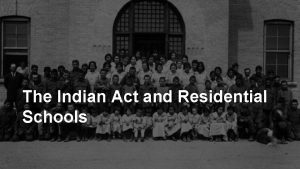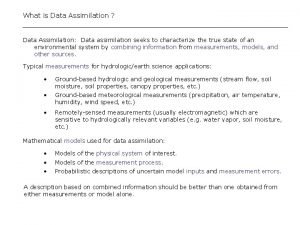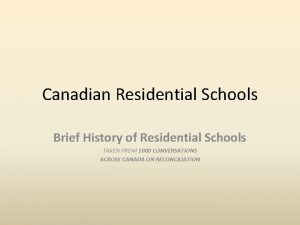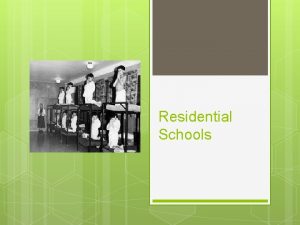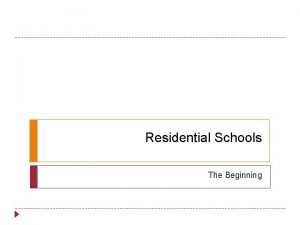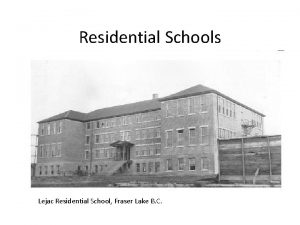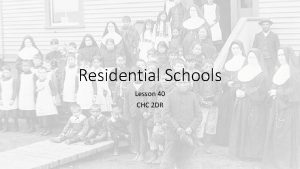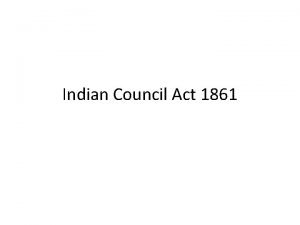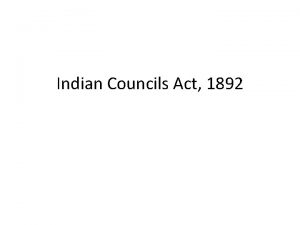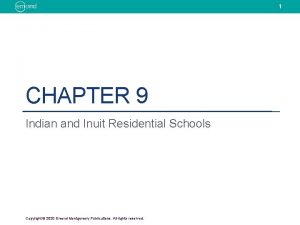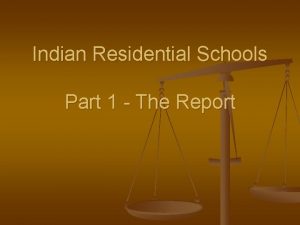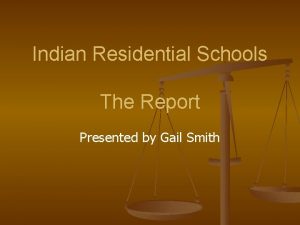Indian Act Residential Schools Assimilation and Control Act


























































- Slides: 58

Indian Act Residential Schools

Assimilation and Control • Act presented as a simple consolidation of existing legislation, added many powers to federal government and its ability to control FN people. • Furthered government’s assimilation policies set out in the 1857 Gradual Civilization Act and in 1869 Enfranchisement Act. • Goal of assimilation highly Eurocentric: worldview that European cultures and traditions were superior to other cultures and traditions. • Believed best future for FNMI people would be one that gave up their own cultures in favour of European-based traditions.

Assimilation and Control • Cultural suppression was one tool of assimilation, but the main instrument of assimilation, for many years, was enfranchisement. • Until 1951, Indian Act defined a person as “an individual other than an Indian” • To become a “person” as defined by the act, FN people had to enfranchise, giving up their status under the Indian Act. • Canadian government believed that offer of enfranchisement would encourage FN people to give up their Indian status.

Assimilation and Control • “Assimilation is legislated genocide. Assimilation is the Indian Act, government legislation and policies from act used to keep FN people from advancing and being part of Canada. • IA’s powers so far-reaching that Canadian government would make changes to the act without consultation with or obtaining permission from FN. • Far reaching powers contrasted sharply with the spirit and intent with which the Numbered Treaties were being negotiated. • Indian Act paternalistic. • Paternalism: policy or practice of governing a group of people by providing for their needs without giving them any rights, as a father might deal with his children. – To assimilate FN people through enfranchisement – Manage FN communities and their reserves – Define who could and could not be classified as a FN person.

What is enfranchisement? • Enfranchisement is when an Aboriginal gave up all claims to land their rights and was no longer considered an Indian under the law. • Through giving up ones Indian status, they would receive full citizenship “privileges”

Citizenship Privileges • First Nations would have to surrender their culture and lifestyle, take up agriculture, convert to Christianity, accept white education. • Adult males deemed of good character, free of debt, and fluent in English or French were eligible. • After a probation period of three years, they could apply to relinquish their treaty and status rights under the Indian Act, and their right to live in the reserve community.

Citizenship Privilages • In return, gained British citizenship with all legal privileges including the right to vote, and private ownership of their share of band reserve lands and funds. • First Nations of western Canada initially excluded, because the government considered them still too “uncivilized”. • The process of enfranchisement no longer exists… Or does it? • https: //globalnews. ca/news/3743373/lynn-beyak-senatorstatuscards/? utm_source=Global. Winnipeg&utm_medium=Faceb ook

Enfranchisement a Flop • Voluntary enfranchisement did not work the way the government had hoped. • Policy was a failure. Few First Nations agreed to give up their status and identity voluntarily. • Meant complete assimilation and absorption into white society, surrendering any benefits and protection offered by the treaties; entering a society that was already racially charged against them. • Only 102 applied and were enfranchised between confederation and end of WW 1. • Many FN saw that enfranchisement as a non viable option.

The Indian Act, 1876 • Since Royal Proclamation of 1763, colonial governments developed a variety of laws concerning First Nations. • After Confederation, with planned expansion west, Canadian government wanted a single framework from which to deal with all First Nations. • 1876, consolidated all previous legislation concerning First Nations in the Indian Act.

Government Perspective - Assimilation • Treaty process and reserve system were temporary. • Stats and reports indicated that the First Nations were a dying people • Government believed that alleviating the suffering of this dying race by easing its assimilation into white society. • Macdonald viewed it as an inevitable process, pointing out, “The great aim of our legislature has been to do away with the tribal system and assimilate the Indian people in all aspects with the inhabitants of the Dominion, as speedily as they are fit for the change”.

Indian Act (1876) • Regulated all aspects of First nations peoples’ lives. • Send Indian Agent – All powerful, could dismiss chiefs and implement treaties • Legally defined the First “wards of the government”. Were to be treated as minors or children, would not have same rights and privileges of citizenship as Canadian citizens. • Certain ceremonies and traditional participation of women and Elders in FN governance not allowed • Defined what it was to be “Indian” (definition always in flux in order to fit the shifting needs of the government)

Indian Act (1876) • Who qualifies as Treaty Indian? – Indigenous person who belonged to a recognized band who’s family member had signed a treaty and lived on a reserve. Called Status Indian. – Only status Indians would be eligible for the provisions under the act. – Non status Indians had no rights – If an aboriginal married a white person: • Treaty man marries white woman, children remained status. • White man marries Indigenous woman, women and her children lose their status. • Changed in 1985. • Controlled every aspect of Indigenous life.

Indian Act (1876) • FN who obtained a university degree, joined the military, or became member of the clergy forced to give up their status. • Set out one universal governing structure for all First Nations, despite the fact that various tribes differed in culture and tradition. – Reserve was to have band council. – Band: act’s terminology for each FN group. • Government controlled most financial matters on reserves, especially sale and rent of reserve lands. Lands could not be mortgaged or taxed. Could also not be sold without majority approval of band members, could be sold only to government.

Indian Act (1876) • Children required to attend residential schools: boarding schools for FN children. • Removed FN children from their families and pressured children to give up their culture and traditions and assimilate into Euro-Canadian culture. • The Act effectively became Ottawa’s tool in handling, controlling, manipulating, and assimilating the First Nations. • Altered more than 100 times since creation. Whenever the government decided that it needed to alter its handing of this population, it amended the Act.

Main Provisions of the Indian Act • *** What do you think some of the consequences of the Canadian government making FN people “wards of the government” under the Indian Act?

Impact of the Indian Act on First Nations Identity and Registration • Defined who could and could not have Indian Status. All status Indians recorded as “Registered Indians” of Canada. Federal government, not individual FN, still has authority to decide who may and may not be registered.

Impact of the Indian Act on First Nations • Depending on terms of treaty status, status Indians may be eligible to: – Live on a reserve – Have extended hunting and fishing seasons – Receive free post-secondary education – Have fewer restrictions on owning firearms – Be exempt from federal and provincial taxes on reserves – Receive a variety of other payments or benefits

Impact of the Indian Act on First Nations Because having Indian status allowed for some level of cultural protection, First Nations people often registered government attempts to persuade them to become enfranchised and give up their status. - Indian act gave government authority to take away Indian status from FN people who joined military, obtained university degree, or became member of the clergy, with or without their permission.

Impact of the Indian Act on First Nations - A revision to the Indian Act in 1879 led government officials to encourage Metis people who had taken treaty and were living on reserves to give up their treaty status and take scrip instead. - Living conditions on many FN reserves were so poor that many Metis accepted the offer. Scrip often sold immediately for much needed cash to pay for basic needs, but at the cost of long-term security. - Often scrip sold to land speculators for up to half its face value. Many speculators became wealthy in the process.

The Indian Agent • 1880 – Canadian government established Department of Indian Affairs. • Within department, Indian agents appointed to carry out terms of Indian Act on reserves. Roll of IA’s all-encompassing. • Represented Canadian government on reserves and had many judicial, economic, and social roles. • Could arrest individuals and hand down sentences.

The Indian Agent • Decided how reserve land was to be used and divided up, and distributed agricultural supplies promised in treaty provisions. FN people could not produce or sell any type of goods without written permission of the Indian agent. • Could even decide how someone’s property and goods were to be distributed when one died. • Faced organized resistance, especially when they tried to prevent traditional ceremonies. • To control people on the reserve, Indian agents frequently withheld or awarded additional rations. Rations included flour, sugar, tobacco, tea, and meat. Indian agents ruled almost all aspects of the lives of FN people on reserves and were part of FN reserve life until the 1950’s when their role was slowly phased out.

Gender Distinctions • • Indian Act discriminatory towards FN women FN had strong traditions of gender equality Changed equality in Indian Act emphasized male lineage and defined the term Indian as “any male person of FN heritage who belonged to a particular band, a child of such a person, or a woman who is or was married to such a person.

Gender Distinctions • If a first nations woman with Indian status married a non-FN man or a FN man without Indian status, she lost her status automatically, as did her children. • Wives of status Indians, whether of Aboriginal background or not, gained Indian status along with her children. • Traditional FN practices often saw women involved in running the day – to – day activities of First Nations communities, as well as having roles in community governance. • After Indian act, women not allowed to be part of government or political process. Gender inequality reflected Euro-Canadian society at the time, where women were not permitted to take part in government or political process.

Band Councils • IA changed traditional forms of government for FN. Made no accommodations for different types of traditions of FN governments that had existed across the system of government for all reserves. • Each reserve was to be governed by a band council, consisting of a chief and council elected for a three-year term. Only adult males in each band could vote for council members. • Chief and council were to be guided by federal government and the Indian agent.

Band Councils • Concept of elections foreign to FN. • In FN traditions, leaders often chosen by a number of factors: including skills, experience, and hereditary status. • Election process allowed this practice to continue, but with less flexibility by community participation than in many traditional governing processes. By imposing the election process, the government hoped that First Nations would give up their traditional government system and adopt European styles of governance.

Ban of Cultural Practices • Under pressure from missionaries, the federal government attempted to assimilate the FN by outlawing cultural practices. • Attempted to slowly extinguish FN languages and culture. • Saw the potlatch ritual from the west coast as offensive, (the giving away of gifts in the ceremonies, because it reinforced FN beliefs and practices) • Government used various tactics, including making it an offence in the amended Indian Act of 1884 to “encourage or participate in the potlatch”. • Amendments to Indian Act forbade FN people from wearing traditional clothing off reserves and from practicing traditional ceremonies such as potlatch and sun dance.

Suppression of the Potlatch • Important ceremony for FN of Northwest Coast. • Church groups and Indian agents looked negatively upon the potlatch because the ceremonies celebrated and reinforced traditional spiritual beliefs, Elders used potlatch to teach younger generations about their culture. • Missionaries and Indian agents argued that if FN people were to be assimilated into European ways, traditions like the potlatch would have to be stopped. • 1884 – ban prohibiting potlatch introduced into Indian Act.

Suppression of the Potlatch • Despite the ban, many FN continued to hold the potlatch in secret. IN the 1920’s, Government of Canada and British Colombia increased their enforcement of the law. Many FN people arrested for participating in ceremony, some sent to jail. • To avoid jail sentences, FN could hand over their ceremonial masks and gifts to authorities. • Government paid them small amount for items then shipped objects to various museums in Canada and the US. • Although government made many efforts to abolish the potlatch, ceremony survived. • Many continued ceremony throughout the ban, finally lifted in 1951. • Continues to be an important ceremony for many FN in BC today.

Suppression of the Sun Dance • Spiritual ceremonies practiced by the Plains Cree, and nations of the Blackfoot Confederacy. • Celebrates community thanksgiving, while also reaffirming many traditional spiritual and cultural values. • Ceremonies often misinterpreted by Euro-Canadian observers, did not understand ceremonies’ cultural significance and meanings. • Indian Act amended to make it illegal to perform some aspects of the ceremony. • FN on prairies continued to perform the sun dance in defiance of the law. • 1951 – amendments to Indian Act reversed the ban so all parts of dance could be legally performed. • Remains a sacred ceremony held on some reserves today. • Ban only forced rituals to be practiced subversively.

Pass System • During North-West Resistance of 1885, Canadian government alarmed at involvement of some FN and anted to ensure that other FN would not support the resistance. Government created a PASS SYSTEM for FN people on reserves. • Under system, FN people restricted to their reserve territory. If wanted to leave the reserve, had to obtain permission, or a pass from the Indian agent. Although the pass system never became a law, it was enforced as one. • Criminal offence for a FN person to be caught outside of ones own reserve land without a pass. North West Mounted Police helped Indian agents enforce the use of passes, which remained a part of reserve life until 1951.

Economic and Political Marginalization of Reserves • Main idea behind reserves was to encourage FN people to adopt agriculture and other Euro-Canadian ways of life. • Lands allocated to many FN not always suited for agriculture. In Cree, the word for reserve is iskonenkun, which means the land that is leftover, not good for anything. • Indian Act honoured the Royal Proclamation, which stated that FN land was the property of the British Crown, and FN lands could be sold only to the government or Crown. • As result, FN could not mortgage or sell their land to make money to invest in agriculture or other projects to develop economy.

Economic and Political Marginalization of Reserves • Natural resources on reserve lands, such as lumber, also remained property of the Crown. • Reserves placed far enough apart to discourage groups of FN from forming alliances. This practice resulted from government’s fear that FN would resist government policies aimed at their assimilation. • Also often far away from non-Aboriginal settlements, led to isolation and alienation. • Although negative in most cases, there were some positives. Reserve system helped protect many FN traditions and helped communities continue to maintain traditional ties of families and clans.


Residential Schools

RESIDENTIAL SCHOOLS • Treaties included provisions for government to provide schooling for FN youth. • FN hoped access to education would support survival of own culture, while enabling children to read, write, and interact with Euro-Canadian settlements. • Government had different ideas about the purpose of educating First Nations youth. • “The education of Indians consists not merely of training the mind but of weaning from the habits and feelings of their ancestors and the acquirements of the language, arts, and customs of a civilized life. ”

Policies of Assimilation • Education strongly used to assimilate the First Nations people into Euro-Canadian culture. • Schools for FN people existed prior to Number Treaties. Mission schools (day schools) introduced soon after European contact and were a significant reason for missionary immigration to Nouvelle-France. Students attended mission schools during the day and returned to their families at night. • Mission schools encouraged FN students to give up their traditional beliefs for Christianity and to learn European styles of living. By 19 th cent, ideas about the purpose of First Nations schools began to change.

Residential Schools and Inuit and Metis Peoples • Liddle consideration until the 1930’s given to educating Inuit youth. Residential schools in Arctic communities began in the 1950’s. Often more than 1000 km away from the children’s homes and families. • Due to the distance, Inuit children who attended residential schools away from their families for up to ten months at a time. • While government initiatives for educating Inuit peoples came late, government simply ignored educational needs of Metis people. • Federal government focused its educational funding on FN and, where space permitted, Metis students who followed many FN ways of life.

Residential Schools and Inuit and Metis Peoples • Government’s educational goal was assimilation, those who lived like Euro Canadians already were seen as “needing” the residential schools. • Metis children not forced to attend residential schools, many did so as one of their only options for receiving formal education. • Schools located near large Metis communities often had many Metis students. Metis children faced same conditions as FN youth in residential schools. Students denied a place in public schools due to racism, poverty, and variety of other factors. Many Metis children fell through the cracks and received no formal education.

Aims of Residential Schools • 1879 – Nicholas Flood Davin, MP, sent to investigate system of residential schools in the US. • Advocated separating Native American youth from their families and reserves to encourage and adopt European ways of life. • Upon return to Canada, Davin recommended Canada adopt a similar policy. • Government receptive to Davin’s recommendation, became convinced, especially after the North-West Resistance, that assimilation of the First Nations people was the best way to avoid conflict. •

Aims of Residential Schools • Designed to make the Indigenous population self sufficient “good Canadians”. • 1894 – over 45 residential schools in Canada, 1930’s – 80 schools. • 1920 – amendment to the Indian Act made it compulsory for FN youth to attend residential schools. • Children as young as six forcibly removed and transported away from their families to residential schools, often a great distance from FN communities to remove students from the influence of their families for extended periods of time.

Aims of Residential Schools • In schools, children separated from their siblings, given European-style clothing, and allowed to speak in English only. They could not speak their own language. • If FN youth caught speaking their traditional language or talking to family members, they were punished. • By discouraging FN languages, educators hoped that the oral stories providing the foundation of FN cultures would die, severing the youth from any ties to their own culture. • School designed to “kill the Indian in the child”.

Thomas Moore • 1897 - The Department of Indian Affairs published before and after pictures of Thomas Moore, who had entered the Regina Indian Industrial School in SK. • What point do you think the Department of Indian Affairs was trying to make by showing these pictures?

Role of the Church • Churches believed needed to play important role in educating FN people since the early years of European colonization. • Anglican, Methodist, Presbyterian, and Roman Catholic churches became involved, although schools funded by the Canadian government. • Churches believed were acting in best interests of FN children and helped to furthered the government’s assimilation goals. • Because residential schools operated by churches, many teachers were priests, nuns, or ministers. Lessons focused on four subject areas: reading, writing, mathematics, and Christian faith.

SCHOOLS • Schools became third, and most draconian of the assimilation schemes. • Federal government realized some of the treaty promises were very expensive, education most expensive. • To offload the costs and responsibility, Ottawa gave Christian missionaries control of the reserves and residential schools. • Among the RS’s were industrial schools that taught skills in agriculture and trades for boys and household skills for girls between the ages of 14 -18. The first three established in western Canada from 1883 -84.

SCHOOLS • Residential Schools characterized as “ineffective, harsh, and unsafe”. Church workers taught the Native children in English or French to become Christians, to denounce their own cultural traditions, and to assimilate into “white” society, especially to become farmers • Some in Eastern Canada adjusted, most did not to the farming lifestyle. • In western Canada, First Nations farms consisted of a small piece of land, poor quality soil, and a few rudimentary implements. • Described as “two acres and a cow”.

RESIDENTIAL SCHOOL SYSTEM • Overall, students had a negative experience. • Overcrowded, poor sanitation, little health care. • Low quantity and quality of food, and severely underfunded • Strict rules: students severely punished if they broke the rules • Suffered horrendous abuse from residential school staff; physically, emotionally, psychologically and sexually. • Some beaten, strapped, shackled to beds, needles shoved in tongues for speaking in native tongue • Reports of assault, rape, threats from staff and students

RESIDENTIAL SCHOOL SYSTEM • Students had braids and long hair cut short. Boys and girls kept separate and were forced to wear uniforms. • Provided education up to grade 5, some took until age 18. Students were discouraged to go to post secondary school. • Spent only half-days in class, the other half was spent doing chores for the school. • Male students were trained for manual labour and unskilled work. Female students were trained in • Abuses and poor conditions resulted in high death toll – 24% died in residential schools. Many died upon returning home. • Some died attempting to run away

Chanie Wenjack • Young Ojibwe boy who died while walking on the railroad tracks trying to find his way home while escaping from Cecilia Jeffrey Indian Residential School. • 400 miles away from home. Didn’t know how far away, or where, his home was. • “It is unlikely that Charlie ever understood why he had to go to school and why it had to be such a long way from home. It is even doubtful if his father really understood either. ” (Macleans, The Lonely Death of Chanie Wenjack)

Discussion – – – – – Do the illustrations affect your interpretation of the text? Whose perspective is being demonstrated? What are the significant events taking place in the image? Based on what you have read, what conclusions can you draw about how residential school survivors have been affected by these experiences? How did the events illustrated change the social interactions within contemporary Canada? Why should learning about Residential Schools be important to a Canadian Citizen? What was the reasoning behind this system? Does it still affect contemporary Canada? What might have people thought about Residential Schools in this time period? Would there have been public support for them? Should we cast judgment? Or instead focus on reconciliation?

Consequences and Result • Undermined Aboriginal culture across Canada • Cultural Genocide – tried to prevent the passing on of Indigenous cultures • Removed from home, stripped from families. Students grew up without having experience of a loving, nurturing family life. • Resulted in lack of knowledge and skills to

Consequences and Result • Formal apology on June 11, 2008 from Steven Harper • Very few survivors had positive experience • Survivors had low self-esteem. Led to selfabuse, alcoholism, substance abuse, and suicide. • Feel like they do not fit into society • Fostered mistrust in education system.

Consequences of Residential Schools • June 11, 2008 – Stephen Harper issued statement of apology on behalf of the Government of Canada for the residential school system. • System was devastating for FN people across the country, as well as for the Metis and Inuit people who attended such schools. • Many former students have come forward with stories of punishment, abuse, and the effects of being deprived of their heritage and culture.

Consequences of Residential Schools • Some students severely punished for maintaining traditional languages, ceremonies, and beliefs. • Although type of punishment children experienced varied, many accounts of being deprived of food and water, being forced to do additional chores, or being ridiculed in front of fellow students. • In some schools, staff used their position of power to inflict emotional, mental, physical, and sexual abuse on students. • One of most damaging outcomes of residential schools was that FN children taught to believe their cultures were inferior to Euro-Canadian cultures.

Consequences of Residential Schools • Children often away from families for months and sometimes years at a time because government believed that students would return to their traditional ways if they visited home. • After several years of being in school, many students had trouble speaking their traditional language and found it difficult to communicate with their families and community members. Problems caused by residential school system reached beyond individuals who attended and included other family and community members, as well as younger generations. • Another long term consequence of residential school system resulted from inferior education FN children received compared to other Canadian schoolchildren. • Less than half the day was devoted to learning. Rest of the day spent in “practical education”, consisted of manual labor and chores to keep the schools functioning.

Consequences of Residential Schools • Students taught practical skills such as sewing and woodworking. • Few schools attempted to prepare students for professional or leadership positions. • As students began to share their stories of conditions in the residential schools, many FN, Metis, and Inuit families refused to send children away, regardless of consequences. • By 1970’s and 80’s, schools began to be closed down. • The last government funded residential school closed in 1996. • *** List the intended and unintended consequences of the residential school system. How many of the consequences were caused by Eurocentric ideas?

Truth and Reconciliation Commission • Calls to action • http: //www. trc. ca/websites/trcinstitution/ind ex. php? p=3

Where are the Children? • http: //wherearethechildren. ca/en/stories/ • Choose and watch one of the interviews with a residential school survivor, and answer the following questions in a 2 -3 page paper, 12 pt font double spaced. You will be asked to share your essay with the class in an oral presentation. • Please include your references, and a title page.

Assignment • What is his/her name • Where did he/she come from? • How old were they when they entered residential school? • What do they remember from their childhood prior to residential school? • What was their experience like in the school? • Was their experience positive or negative? Why? • How did residential school affect them today?
 Before and after residential schools
Before and after residential schools Metlakatla indian residential school
Metlakatla indian residential school Residential schools in saskatchewan map
Residential schools in saskatchewan map Residential schools canada
Residential schools canada Residential schools horror stories
Residential schools horror stories Residential schools
Residential schools Residential school photos legacy erasure
Residential school photos legacy erasure Map of residential schools in canada
Map of residential schools in canada What is a target school
What is a target school Indian boarding school the runaways
Indian boarding school the runaways Huntsville powerschool
Huntsville powerschool 4 parts of digestive system
4 parts of digestive system Villi adaptation
Villi adaptation Pluralism and assimilation
Pluralism and assimilation Allotment and assimilation
Allotment and assimilation Unit 7 cognition ap psychology
Unit 7 cognition ap psychology Regressive assimilation examples
Regressive assimilation examples Regressive assimilation examples
Regressive assimilation examples Regressive assimilation
Regressive assimilation Fat test
Fat test Example of assimilation in child development
Example of assimilation in child development Dissimilation rules
Dissimilation rules Assimilation vs accommodation psychology
Assimilation vs accommodation psychology Minimal pair in english
Minimal pair in english Complementary distribution examples
Complementary distribution examples Phonological processes
Phonological processes Phonology process
Phonology process Branch of linguistics dealing with meaning
Branch of linguistics dealing with meaning Word stress
Word stress Elision in english examples
Elision in english examples Assimilation ap psychology
Assimilation ap psychology Complementary distribution examples
Complementary distribution examples Assimilation is indicated by the letter(s) _____.
Assimilation is indicated by the letter(s) _____. Nitrogen assimilation in plants
Nitrogen assimilation in plants Jedi data assimilation
Jedi data assimilation Weak forms examples
Weak forms examples Progressive assimilation beispiel
Progressive assimilation beispiel Assimilation of mineral nutrients
Assimilation of mineral nutrients Data assimilation
Data assimilation Assimilation exercises with answers
Assimilation exercises with answers Data assimilation tutorial
Data assimilation tutorial Celebrate recovery new life church
Celebrate recovery new life church Process of ingestion
Process of ingestion Assimilation westward expansion
Assimilation westward expansion Data assimilation
Data assimilation Data assimilation
Data assimilation Data assimilation
Data assimilation Data assimilation
Data assimilation Data assimilation
Data assimilation Assimilation acculturation
Assimilation acculturation Assimilation process
Assimilation process What is cultural assimilation
What is cultural assimilation Progressive assimilation examples
Progressive assimilation examples Allophones examples
Allophones examples What is assimilation
What is assimilation Assimilation exemple
Assimilation exemple What is assimilation
What is assimilation Slidetodoc
Slidetodoc Indian act 1876
Indian act 1876

